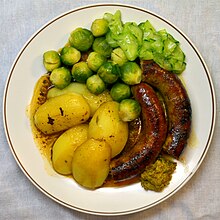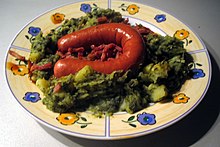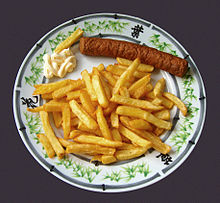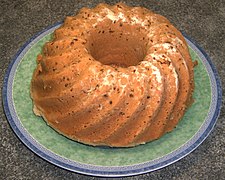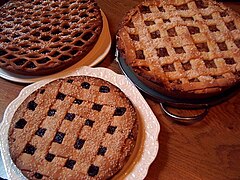Dutch cuisine
The Dutch cuisine is comprised of various regional cooking styles and culinary specialties in the Netherlands. Traditional Dutch cuisine is characterized by simple and hearty dishes; important ingredients are vegetables , milk , butter , cheese , meat and fish . Depending on the region, it has strong overlaps with the kitchens of neighboring regions, for example East Frisian cuisine in Friesland and Rhenish cuisine in the southeast and Belgian-Flemish cuisine in the south and southwest.
Since the 17th century, in the Golden Age , the kitchen of the traders in particular has also been characterized by rich and overflowing tables with hearty and heavy dishes. At the same time, however, it also includes a large number of salads, hearty vegetable stews and dairy products from the rural population. In the 20th century, Dutch cuisine was mainly supplemented by Indonesian influences, as Indonesia, the Dutch East Indies, was a Dutch colony for a long time. The snack culture with numerous fried dishes and the typical “snack bars” has also been able to establish itself strongly in the last few decades, especially in urban regions.
The cuisine of the Dutch Antilles , which officially belonged to the Netherlands until October 2010, is independent of the classic Dutch cuisine . This is a cuisine with numerous different influences, which partly corresponds to the Caribbean cuisine and complements it with Spanish and Dutch ingredients.
Meals

In the Netherlands, five meals are traditionally spread throughout the day, although this has been reduced to three standard meals until now. The once typical Dutch breakfast ( ontbijt ) consists of several types of bread , often with a sweet topping. Classically, the toppings are honey and jams , but nowadays mainly chocolate sprinkles and chocolate flakes ( hagelslag , vlokken ) or peanut butter ( pindakaas ). Nowadays, cold cuts and cheeses are eaten for breakfast in equal measure. In addition, there is traditionally the honey cake ( ontbijtkoek ), popular in the Netherlands , rusks with butter and a porridge known as pap (porridge, wheat porridge). Muesli, corn flakes and other cereals are also eaten a lot.
Breakfast is usually supplemented with a cup of coffee or tea or fruit juice; children usually drink milk, fruit juice or cocoa. In the morning the coffee break follows, during which the Dutch take their coffee with small cakes, biscuits and other sweets.
Noon to be Middageten or lunch sandwiches similar to the usually sandwiches ( broodjes eaten), wherein the coating is mostly hearty here and consists of cheese sausage and fish. In addition, there are small warm dishes such as the Uitsmijter , which corresponds to the German Strammen Max , as well as salads, cheese, fruit and other small dishes, including rolpens or small meat and liver skewers. Milk or buttermilk is often drunk with this lunch .
Groninger Mettwurst
In the afternoon there is another tea hour with tea, coffee and cake. The well-known kopje koffie (“cup of coffee”) is also offered to guests around the clock, and tea is also very popular. A biscuit or a slice of cake is served for each cup or glass. The fruit tea , which is widespread in Germany, is rarely found in the Netherlands, but it is flavored black tea.
The main meal is dinner ( avondeten ), which consists of warm dishes. As a rule, a typical Dutch dinner is potatoes, meat or fish with sauce and a vegetable side dish, alternatively a hearty stew. The importance of vegetables is slightly higher and that of meat slightly less than in Germany, this fact manifests itself in correspondingly larger or smaller proportions of vegetables and meat than is usual in Germany. The proportion of the classic, colloquially Aardappels-Groente-Vlees (potatoes-vegetable-meat) called standard meal has been falling sharply for decades in favor of z. B. Rice and pasta dishes.
This main meal typically ends with sweets in the form of a dessert ( toetje ), often pudding or porridge such as sweet semolina gruel ( semolina pudding ), macaroon pudding ( bitterkoekjespudding ), vanilla / chocolate vla (a type of liquid pudding), yogurt with fruits, or Ice. Pancakes ( pannenkoek ) are also commonly eaten and can be used both as a main course and as a dessert. Cheese as a way to end a meal is not common in the Netherlands, while the main drinks at dinner are sparkling water, fruit juice, wine and beer.
In rural, more agrarian regions, the main meal in the form of warm dishes is sometimes consumed at lunchtime, especially by the older generations. In this case there is dinner in the evening, just like in Germany. However, this practice has been in decline for decades.
dishes
Classic stews
Down-to-earth stews are very popular in the Netherlands and go back to the farming tradition of the Netherlands. These are usually hearty stews made from potatoes and vegetables, which are typical of Dutch agriculture. These dishes are mainly “winter dishes”, which are eaten as hearty and filling dishes in cold weather. The former national dish is the Stamppot ( "mashed pot"), a mixture of mashed potatoes and vegetables. Often kale ( Dutch Boerenkool , literally: "Farmer's cabbage ") is used. Usually stamppot is eaten with hot rookworst , a smoked ham sausage, or bacon and fried onions . Rookworst is also often served with sauerkraut. Another variant of Stamppot is the Hutspot (from 'husselen' = 'to mix'), also a mashed mixture, this time of potatoes, onions and carrots. It is eaten with minced, fried bacon or beef ( klapstuck ) and, according to legend, goes back to the liberation after the siege of the city of Leiden by the Spanish in the 16th century. Endive is also optionally used as a vegetable .
Another popular dish is Dutch pea soup ( Erwtensoep , also Snert ), which consists of dried split peas that are soaked in water overnight and cooked together with bacon to make a soup. In addition, in some areas of the Netherlands, a rye bread is spread with butter and served with cooked bacon.
fish and seafood
In the Netherlands, fish and seafood are mainly eaten in the coastal regions, but they are also popular away from the coast. Especially the herring plays a central role and is in the form of young herring known far beyond the Netherlands. It is a raw and salted herring fillet , which is eaten with or without onions on the tail, held upside down or with a white bread roll, especially during the herring season. The herring is also fried as fresh (“green”) herring ( Panharing ) or cooked ( Gekookte verse haring ) and the Matjes is also used to prepare herring salad ( Haringssla ), herring casseroles ( Prinsesse-aardappelen or Haringsschotel ) and for pan -fried dishes such as the Haarlemer herring pan ( Haring spot uit Haarlem ) used.
Other saltwater fish, which are often used in the Netherlands, which are in the North Sea common cod , haddock and sole , halibut and plaice . The proportion of fish from aquaculture such as rainbow trout , salmon , pangasius and tilapia has been increasing rapidly for years. Also mussels and shrimps belong to traditional Dutch cuisine.
meat and sausage
As in the neighboring regions, meat and sausages are very much valued and prepared in a variety of ways. Meat farming is particularly widespread in the south of the Netherlands, with pigs , cattle and poultry in particular . Pork is the basis for numerous dishes and ingredients, and it is often used in the form of bacon or processed as minced meat and sausage. Besides playing pork as important as the beef and various poultry dishes. In the forest areas in the center and south of the country, there is also game in the form of roe deer and deer meat as well as game fowl.
Cheese and dairy products
The Dutch cheese ( kaas ) is internationally known and is eaten both as a topping on bread and cut into pieces. These are usually semi-hard cheeses made from cow's milk. Above all, the spherical Edam cheese ( Edammer Kaas ) was already traded beyond the borders of the Netherlands in the Middle Ages and was one of the country's most important export goods . The cheese was shipped from the former port city of Edam across the North Sea and the Baltic Sea to Germany, Denmark and the Baltic States and south to France and Italy. After the connection to the Zuidersee , today's IJsselmeer , was drained for land reclamation in the 1920s to 1930s, trade with the Edam was discontinued. Today the most widespread and internationally best known is Gouda ( Goudse kaas ), which has its origins in the city of the same name in Gouda in South Holland and is produced in large loaves weighing up to 30 kilograms.
Dutch cheese is divided into different degrees of ripeness. Jonge Kaas is stored for the shortest time and tastes creamy mild. Documents is the next level with a spicy flavor and a firm texture. Oude Kaas is the most aromatic (and most expensive) storage grade. In order to mark cheeses from the production of Dutch farms and agricultural businesses in relation to the large industrial cheese dairies, they have an oval sticker and are marked as “Bauernkäse” ( Boerenkaas ).
Other traditional and well-known cheeses from the Netherlands are the Commission cheese ( Commisie Kaas ), the Beemster , the Kernheimer and the Friesekaas , while the Maasdammer and the Leerdammer are newer developments based on the Gouda and Edam. The Friese Nagelkaas (Frisian clove cheese) is a semi-hard cheese seasoned with cumin and cloves and the Leidse Kaas (Leiden cheese) also contains cumin, while the Drentse Kruidenkaas (Drent cheese herbal cheese) contains a mixture of herbs. In addition to these cow's milk cheeses, there is also Hollandse Geitekaas , a goat cheese , and Schapenkaas (sheep's cheese) in the Netherlands . The best-known soft cheese is Mon Chou , a white mold cheese in the French Neufchâtel style .
In the Netherlands, the cheese is usually eaten directly or on bread. In addition, he is also used for some more food as an ingredient, such as the browning of casseroles or cheese potatoes ( Kaasardappelen ; cheese-topped potatoes), as a support to the Pannenkoeken for pastries such as the Kaastengels or for typical Dutch Frittierwaren such as the kaassoufflé .
pancakes
In addition to the cheese, the Dutch Pannenkoeken are particularly well-known and there is hardly a place in the Netherlands without a typical Pannenkoekenhuis . The preparation of the pancakes is the same as that of the thick egg pancakes , which are also common in Germany ; the batter usually consists of eggs, flour and baking powder with a pinch of salt. The typical simple Pannenkoek is with sugar syrup , Stroop , drizzled and eaten. There are also hearty variants such as the Spekpannenkoek with mixed bacon and the sweet Appelpannenkoek with apple slices. The Gemberpannenkoek is served with pickled ginger slices .
Snack culture
The Netherlands are known today primarily for their snack culture, which is shown in numerous food stalls , in the Netherlands “snack bars”. In addition to French fries from Belgium, the snack bars also offer various fried meat and cheese dishes. Typical snacks are the frikandel (or frikandel speciaal ), kroket (with beef , veal , vegetable , goulash or chicken filling ), bami or nasischijf or bami or nasibal (breaded and fried slice or ball made of bread Bami Goreng or Nasi Goreng ), Kaassoufflé , Kipcorn , Bitterballen , Gehaktbal and in the coastal towns Kibbeling , deep-fried plaice or "Lekkerbekje" ( pangasius or whiting fried) and various other fish dishes.
The Indonesian cuisine has become the influences of the colonial era established. Patat oorlog z. B. is French fries with mayo, onions and peanut sauce ( oorlog means war, but in this dish it stands for the chaotic combination of ingredients, which is reminiscent of a battlefield). Indonesian influences such as peanut sauce can hardly be overlooked in Dutch cuisine, even if most dishes have been adapted to European taste (that is: little salt and not too spicy).
In the last few decades the number of takeaways has increased significantly. In fast food restaurants you can get french fries ( patat , also friet or frietjes ) with mayonnaise , ketchup (also mixed with onions = speciaal / special) or other sauces like peanut sauce ( pindasaus / satésaus ) or Joppiesauce , a mixture of mayonnaise, curry and onions. In the last few years in particular, variants of traditional snacks such as B. Kapsalon ("hairdressing salon"), a combination of French fries, kebab meat and salad, layered on a plate and in some snack bars baked with cheese.
Pastries and desserts
More traditional Dutch meals are Poffertjes ( pancake -like dessert ), Stroopwafels , Boterkoek , Speculaas , pepernoten (small pepper nut) or Taai-taai (pastry) on Nicholas Eve, Oliebollen ( Boiling pastry , on New Year's Eve consumed), Kandeel (sweet drink on wine base with Egg and cloves ) and bitterballen (small round meat croquettes). Sugar beet syrup (stroop) also plays an important role in desserts and is served as an addition to various pastries, pancakes and cakes such as the Groninger Poffert to be drizzled on or coated with.
The pudding-like Vla as well as the chocolate sprinkles ( Hagelslag ) and colorful sugar sprinkles ( Vruchtenhagel ) used as a bread topping are also very popular .
beverages
The most typical drink in the Netherlands is coffee , which is drunk at almost all meals and after which the “Koffietafel”, the morning meal of the Dutch, is named. The coffee is comparatively strong and is usually drunk with milk and sugar. Also tea plays an important role and is prepared regionally in a typical ceremony in which the boiling water is still bubbly poured over the tea and poured off after pulling into a second, warmed pot. Holland was the first European country where tea spread in the 17th century, and the country has long had a monopoly on the tea trade. Also of cocoa , prepared on the basis of cocoa powder and sugar with warm milk , is often drunk, especially children for breakfast. The milk itself, as well as buttermilk and various mixed drinks based on milk and yoghurt, are often drunk.
The Netherlands has a long tradition of brewing beer. Mainly pale Pils or lager beers ( light ), but also dark monastery beers ( donker ), which are related to Belgian beers, are offered. The Dutch beer market is now dominated by the third largest brewery group in the world, Heineken , which has taken over traditional brands such as Amstel and Brand . Another well-known beer brand is Grolsch , which today belongs to the SABMiller Group.
In addition to beer, there are various typical schnapps, including above all genever , a juniper schnapps with at least 35 % vol. Alcohol content . This is offered as oude (old), jonge and flavored as citroenjenever (lemon genever) or Beerenburg , a herbal spirit based on genever. There are also various brandies and the advokaat egg liqueur is one of the typical Dutch drinks. Thanks to the Lucas Bols liqueur factory, which was founded in the 16th century, numerous liqueurs are also typical drinks in the Netherlands. Apricot brandy and Curaçao are particularly well-known and popular.
Wines and sparkling wines are also popular. Domestic production is low, but already occupied in the southernmost parts of the country in Roman times. Today there are vineyards in many parts of the Netherlands, with only vines grown that can cope well with the cooler climate.
Others
The famous Hollandaise sauce ( Dutch sauce ) comes from classic French cuisine; Holland is only eponymous.
supporting documents
- ↑ a b c d e f g h A day in a Dutch family. In: Barbara Lüdecke: Dutch cuisine. 200 specialty recipes from the Netherlands. Wilhelm Heyne Verlag, Munich 1971.
- ↑ a b c d Solid and down-to-earth: stews. In: Elke Meiborg: Netherlands. In: Joachim Römer, Michael Ditter (Hrsg.): Culinaria - European specialties. Volume 1, Könemann, Cologne 1995, ISBN 3-89508-056-X , p. 344.
- ↑ a b c d A household name worldwide: cheese from Holland. In: Elke Meiborg: Netherlands. In: Joachim Römer , Michael Ditter (Hrsg.): Culinaria - European specialties. Volume 1, Könemann, Cologne 1995, ISBN 3-89508-056-X , pp. 340–343.
- ↑ Size matters: pancakes. In: Elke Meiborg: Netherlands. In: Joachim Römer, Michael Ditter (Hrsg.): Culinaria - European specialties. Volume 1, Könemann, Cologne 1995, ISBN 3-89508-056-X , pp. 346-347.
- ↑ inland area Gedestillierd: gin and liqueurs. In: Elke Meiborg: Netherlands. In: Joachim Römer, Michael Ditter (Hrsg.): Culinaria - European specialties. Volume 1, Könemann, Cologne 1995, ISBN 3-89508-056-X , p. 358.
- ↑ Dutch Wines - Gastronomy - Holland.com. Retrieved April 29, 2017 .
literature
- Barbara Lüdecke: Dutch cuisine. 200 specialty recipes from the Netherlands. Wilhelm Heyne Verlag, Munich 1971, DNB 457465913 .
- Hans Kaldenbach: Doe maar gewoon: 99 tips voor het omgaan met Nederlanders. Prometheus, Amsterdam 1994, ISBN 90-5333-291-X .
- Hellen AM Halverhout: Holland and Belgium at the table. In: Fischer international cuisine. Holland and Belgium. Fischer, Frankfurt am Main 1977, ISBN 3-436-02446-5 , pp. 7-17.
- Jacques Meerman: Little divorced van de Nederlandse keuken. ambo | anthos, Amsterdam 2015, ISBN 978-90-263-3258-6 .
- Elke Meiborg: Netherlands. In: Joachim Römer , Michael Ditter (Hrsg.): Culinaria - European specialties. Volume 1, Könemann, Cologne 1995, ISBN 3-89508-056-X , pp. 336-359.
- Catharina Zierikhoven (Jacques-Alexandre de Chalmot): Volkoomen Neerlandsch kookkundig woordenboek voorgesteld in de Friesche keukenmeid en verstandige huishoudster, emptying op een eenvoudige, duidelyke, en teffens smaakelyke Wyze, bereiden van het sorts spyzen (...) HA de Chalmot, 1772. ( Google Books )



